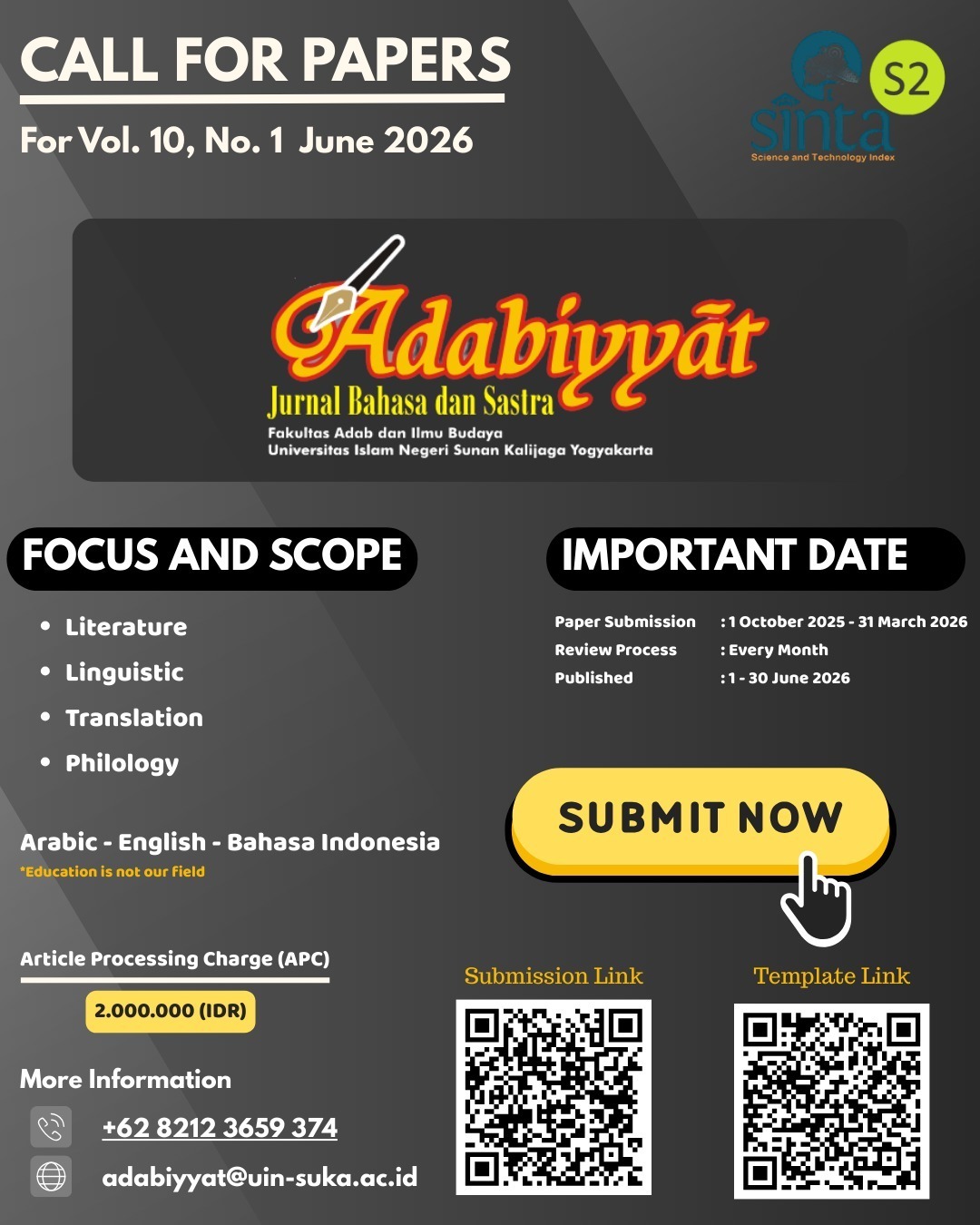DIMENSI PERSONAL DAN DIMENSI KOLEKTIF DALAM BUDAYA POPULER: KAJIAN PSIKOLOGI ANALITIS DALAM FILM FATE: THE WINX SAGA
DOI:
https://doi.org/10.14421/ajbs.2022.06101الكلمات المفتاحية:
Personal dimension، collective dimension، Carl Gustav Jung، Fate، The Winx Saga، popular cultureالملخص
This article tries to explore some of the implication of Carl Gustav Jung’s theory of personal dimension and collective dimension as represented by the characters in Fate: The Winx saga. This film is produced by Netflix and released on 22 January 2021. In this research, film is assumed as media to validate Jung’s theory about human psyche. This research is a qualitative descriptive. The data were processed by analyzing, categorizing, and interpreting the visual codes provided by the film. Therefore, the meaning can be theoretically drawn. The result of this study shows that the personal and collective dimensions offered by Jung are owned by the characters in the film. The personal dimension manifests in the Ego in the form of emotions and memories of the past. This personal dimension is represented through the characters such as Bloom, Musa, and Terra. While the collective dimension can be explained through the persona, shadow, anima and animus shared by all the characters in the film.
التنزيلات
المراجع
Adi, Ida Rochani. 2011. Fiksi Populer dan Teori-Teori Interdisipliner dalam Fiksi Populer: Teori & Metode Kajian. Yogyakarta: Pustaka Pelajar.
Cherry, Kendra. 2020. “The 4 Major Jungian Archetypes.” Verywell Mind. 30 Juni 2020. https://www.verywellmind.com/what-are-jungs-4-major-archetypes-2795439.
Cornis-Pope, Marcel, ed. 2014. New Literary Hybrids in the Age of Multimedia Expression. Chlel.Xxvii. Amsterdam Philadelphia: John Benjamins Publishing Company. https://benjamins.com/catalog/chlel.xxvii.
Derin, Sümeyye, dan Evrim Cetinkaya-Yildiz. 2018. “An Adlerian Analysis of ‘The Kid’ Movie.” TED EĞİTİM VE BİLİM 43 (Maret). https://doi.org/10.15390/EB.2018.6803.
Falsafi, Parinaz, Somayeh Khosravi Khorashad, dan Alireza Abedin. 2011. “Psychological Analysis of the Movie ‘Who’s Afraid of Virginia Wolf?’ By Using Jungian Archetypes.” Procedia - Social and Behavioral Sciences 30: 999–1002. https://doi.org/10.1016/j.sbspro.2011.10.194.
Gherovici, Patricia. 2017. Transgender Psychoanalysis: A Lacanian Perspective on Sexual Difference. London: New York: Routledge, Taylor & Francis Group.
Jung, Carl Gustav. 2019. The Spirit in Man, Art and Literature. Diterjemahkan oleh Cep Subhan KM. Yogyakarta: IRCisod.
———. 2020. Four Major Archetypes: Mother, Rebirth, Spirit, Tricster. Diterjemahkan oleh Aquarina Kharisma Sari. Yogyakarta: IRCisod.
van Leeuwen, Theo, dan Carey Jewitt, ed. 2008. The Handbook of Visual Analysis. London: SAGE Publications Ltd.
Leigh, David J. 2011. “Carl Jung’s Archetypal Psychology, Literature, and Ultimate Meaning.” Ultimate Reality and Meaning 34 (1–2): 95–112. https://doi.org/10.3138/uram.34.1-2.95.
Merritt, Frazer, Dennis Merritt, dan Kevin Lu. 2018. “A Jungian Interpretation of the Hunger Games.” Jung Journal 12 (3): 26–44. https://doi.org/10.1080/19342039.2018.1478558.
Monaco, James. 2000. How to Read a Film: The World of Movies, Media, Multimedia:Language, History, Theory. New York: Oxford University Press.
Palmer, James. 2012. “The King’s Speech: A Jungian Take.” Jung Journal 6 (2): 68–85. https://doi.org/10.1525/jung.2012.6.2.68.
Rizakiah, Syarifah, Surya Sili, dan Singgih Daru Kuncara. 2018. “An Analysis of Main Characters in Warm Bodies Film Using Jung Theory of Archetypes.” Ilmu Budaya: Jurnal Bahasa, Sastra, Seni Dan Budaya 2 (4): 412–25. https://doi.org/10.30872/jbssb.v2i4.1029.
Stein, Murray. 2020. Jung’s Map of The Soul: An Introduction. Diterjemahkan oleh Siska Nurrohmah. Yogyakarta: Shira Media.
Storey, John. 2004. Cultural Theory and Popular Culture. An Introduction. New York: University of Georgia Press.
Straffi, Iginio. 2021. Fate: The Winx Saga. Adventure, Fantasy, Drama. Netflix. https://www.netflix.com/watch/80235274?trackId=200257859.
التنزيلات
منشور
إصدار
القسم
الرخصة
الحقوق الفكرية (c) 2022 M Afifulloh

هذا العمل مرخص بموجب Creative Commons Attribution-ShareAlike 4.0 International License.
- Adabiyyāt: Jurnal Bahasa dan Sastra publishes all articles entirely in full text.
- It is permissible for readers to download and to use it for scientific purposes and scientific dissemination.
- The author can re-publish the article that has been published by the Adabiyyāt: Jurnal Bahasa dan Sastra after obtaining written permission from the editor. This letter can be obtained by submitting a request letter for permission to republish the article to Adabiyyāt: Jurnal Bahasa dan Sastra via email adabiyyat@uin-suka.ac.id. In the second publication, the author is required to include information that the article was firstly published by the Adabiyyāt: Jurnal Bahasa dan Sastra.




















